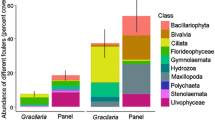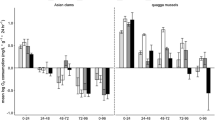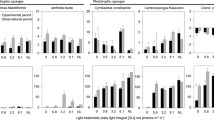Abstract
The only detailed survey aimed at assessing the efficacy of oxygen deprivation for controlling fouling by the golden mussel indicates that, at dissolved oxygen levels < 0.16 mg/L, total mortality is achieved after 10–12 days (at 27 °C) to 21–29 days (at 20 °C). At 20 °C (but not at 27 °C), small (7 mm) mussels are significantly less tolerant than large (20 mm) individuals. Oxygen deprivation may be a viable alternative for the control of mussel fouling in industrial installations.
Access provided by Autonomous University of Puebla. Download chapter PDF
Similar content being viewed by others
Keywords
- Limnoperna fortunei
- Golden mussel
- Biological invasion
- Biofouling control
- Impact
- Industrial plants
- Power plants
- Oxygen deprivation
- Anoxia
Experimental assessment of the tolerance of Limnoperna fortunei to oxygen deprivation was carried out by Perepelizin and Boltovskoy (2011). They exposed small (7 mm) and large (20 mm) mussels to anoxic conditions (< 0.16 mg O2/L, or 1.8–2.2 % saturation) at 20 and 27 °C, for periods ranging between 8 and 31 days, until 100 % mortality in all (3) replicates (with 43 mussels each) occurred.
At 20 °C, small mussels started dying on day 3, with the last of 137 specimens enduring anoxia for 22 d (Fig. 1). Average time to 100 % mortality in all replicates was 20.7 d (LT50: 9.5 d). Large mussels were significantly more resistant: individual survival times were 6–31 d, and average time to 100 % mortality in all replicates was 29.3 d (LT50: 18.0 d) (Fig. 1).
Mortality rates of small (7 ± 2 mm) and large (20 ± 3 mm) Limnoperna fortunei under anoxia. Each curve represents the mean of three replicates. (Modified from Perepelizin and Boltovskoy 2011, from Journal AWWA 103(3) by permission. Copyright © 2011 the American Water Works Association)
In contrast with experiments at 20 °C, large and small animals behaved almost identically at 27 °C. Individual survival times were between 1 and 13 days, and mean time to 100 % mortality was 10.2 (large; LT50: 4.7 d) to 11.6 (small; LT50: 4.7 d) days (Fig. 1).
The distribution of L. fortunei in South America, where it often thrives under extremely adverse environmental conditions (e.g., high pollution levels, low oxygen concentrations, very low calcium levels, low pH; Karatayev et al. 2007) indicates that it is a highly tolerant species. For example, under anoxic conditions at 25 °C, 100 % mortality of Dreissena polymorpha is achieved in only 4 days (Matthews and McMahon 1994) (as opposed to ca. 13 days for L. fortunei). Although the golden mussel can withstand dissolved oxygen levels as low as 0.5 mg/L for extended periods (Karatayev et al. 2007), its ability to survive under extreme hypoxia is limited (Liu et al. 2006). In raw reservoir or river water pipelines, fouling by L. fortunei has been observed to decrease with distance from the intake in association with decreasing dissolved oxygen concentrations (Ye et al. 2011). Ample differences in mussel densities in two closely spaced Japanese reservoirs were ascribed to the lack of dissolved oxygen in one of them (Nakano et al. 2010).
In the upper Paraguay River, seasonally changing water levels are responsible for extensive flooding of vegetated lowlands. During inundation, aquatic plants colonize the area, but die shortly thereafter during the dry season, when water levels subside. In the subsequent flood pulse, the dead vegetation is leached and decomposed, strongly depressing O2 levels and pH values, and raising CO2. These conditions, known locally as “dequada,” which usually last for several weeks, have been found to produce massive mortalities of L. fortunei (Oliveira et al. 2010).
Thus, oxygen deprivation may constitute an adequate solution to L. fortunei fouling. It is environmentally innocuous, economical, and does not involve hazardous substances or operations. As shown by the information reviewed above, as well as by data on other fouling species (Sprung 1995; Johnson and McMahon 1998), it is particularly efficacious at high water temperatures, such as those prevailing for at least some months of the year in most water bodies invaded by this mussel around the world.
Oxygen depletion can be achieved simply by sealing off pipes and precluding water circulation, or with the aid of oxygen scavengers such as sodium metabisulfite or hydrogen sulfide gas (Smithson 1986; O’Neill 1995). Several water treatment plants in Wisconsin, provided with dual intakes, add sodium bisulfite and seal off one of the intakes for 4–10 weeks achieving 100 % mortality of infesting zebra mussels (Mackie and Claudi 2010). Small water treatment facilities drawing water from the reservoir Embalse de Río Tercero (Córdoba Province, Argentina) experienced intake pipe clogging problems due to growth of L. fortunei (Anonymous 2006). Some of them are provided with dual intakes, which allows for temporary capping of a fouled one while using the other until infesting mussels die. Backflushing the sealed-off intake at the end of the inactive period is important for clearing the pipe of dead, loose, and weakly adhering mussels.
However, as with most other control methods, anoxia also has drawbacks. Sealing off an intake for an extended period of time requires that the plant is provided with dual intake pipes, which is not always the case, and retrofitting in order to provide this alternative may be costly and complicated. This obviously also applies to sections other than intake pipes, where duplication of components may be even more costly and problematic. At high temperatures, the response of L. fortunei to the lack of oxygen is fairly fast (around 2 weeks for 100 % mortality at 27 °C; see Fig. 1), but at lower temperatures response times increase significantly. Depending on plant design and operating conditions, the possibilities of shutting off an important section for weeks or months may be limited. In addition, lack of oxygen frequently enhances the abundance of sulfate-reducing bacteria, which are responsible for microbially induced corrosion (Mackie and Claudi 2010).
Anoxia is a nonselective method, killing practically all organisms, but since it normally involves treating a limited volume of water, its environmental impact is negligible.
References
Anonymous (2006) El mejillón dorado (Limnoperna fortunei). Los serios problemas que origina en la planta potabilizadora. NotiCoop (Boletín Informativo de la Cooperativa de Obras y Servicios Públicos Limitada de Villa del Dique, Provincia de Córdoba, Argentina) 42:22–23
Johnson PD, McMahon RF (1998) Effects of temperature and chronic hypoxia on survivorship of the zebra mussel (Dreissena polymorpha) and Asian clam (Corbicula fluminea). Can J Fisheries Aquat Sci 55:1564–1572
Karatayev AY, Boltovskoy D, Padilla DK, Burlakova LE (2007) The invasive bivalves Dreissena polymorpha and Limnoperna fortunei : parallels, contrasts, potential spread and invasion impacts. J Shellfish Res 26:205–213
Liu L, You Z, Luo F, Zhang J, Ouyang S (2006) Killing and removing Limnoperna fortunei from raw water pipe by isolating oxygen. Water Wastewater Eng 22:40–42, 47
Mackie GL, Claudi R (2010) Monitoring and control of macrofouling mollusks in fresh water systems. CRC Press, Boca Raton, pp 1–508
Matthews MA, McMahon RF (1994) The survival of Zebra Mussels (Dreissena polymorpha) and Asian Clams (Corbicula fluminea) under extreme hypoxia. In: 4th International Zebra Mussel Conference, Madison (USA)
Nakano D, Kobayashi T, Sakaguchi I (2010) Differences in larval dynamics of golden mussel Limnoperna fortunei between dam reservoirs with and without an aeration system. Landsc Ecol Eng 6:53–60
Oliveira MD, Hamilton SK, Calheiros DF, Jacobi CM (2010) Oxygen depletion events control the invasive golden mussel (Limnoperna fortunei) in a tropical floodplain. Wetlands 30:705–716
O’Neill CR (1995) Control of zebra mussels in residential water systems. New York Sea Grant Institute, New York, pp 2–10
Perepelizin PV, Boltovskoy D (2011) Resistance of the invasive pest mussel Limnoperna fortunei to anoxia. J Am Water Works Assoc 103:79–85
Smithson JA (1986) Development of a Corbicula control treatment at the Baldwin power station. Am Malacol Bull 2:63–67 (Special Edition)
Sprung M (1995) Physiological energetics of the zebra mussel Dreissena polymorpha in lakes III. Metabolism and net growth efficiency. Hydrobiologia 304:147–158
Ye BM, Cao XW, Xu M, Wang ZY, Lin CC (2011) Study of Limnoperna fortunei invasion in long distance water transmission project. Water Wastewater Eng 37:99–102 [In Chinese]
Acknowledgements
This work was partially financed by grants from the University of Buenos Aires, Argentina (UBA X-020 and 20020100100035) and from the Agencia Nacional de Promoción Científica y Tecnológica, Argentina (PICT 2007 1968) to DB.
Author information
Authors and Affiliations
Corresponding author
Editor information
Editors and Affiliations
Rights and permissions
Copyright information
© 2015 Springer International Publishing Switzerland
About this chapter
Cite this chapter
Perepelizin, P., Boltovskoy, D. (2015). Control of Limnoperna fortunei Fouling by Oxygen Deprivation. In: Boltovskoy, D. (eds) Limnoperna Fortunei. Invading Nature - Springer Series in Invasion Ecology, vol 10. Springer, Cham. https://doi.org/10.1007/978-3-319-13494-9_25
Download citation
DOI: https://doi.org/10.1007/978-3-319-13494-9_25
Published:
Publisher Name: Springer, Cham
Print ISBN: 978-3-319-13493-2
Online ISBN: 978-3-319-13494-9
eBook Packages: Biomedical and Life SciencesBiomedical and Life Sciences (R0)





